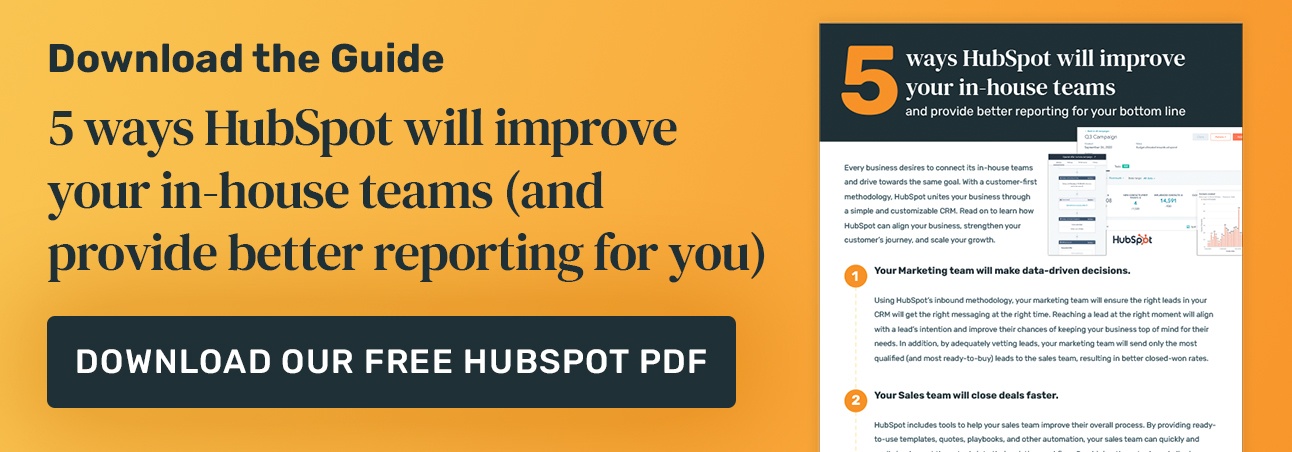Tips on adopting HubSpot's Marketing Hub | Brightlark

Whether it's the beginning of a new quarter or you're looking to make the switch to HubSpot at the end of the year, every business aims to maximize sales while gaining and maintaining customers.
During busy times, businesses can reap the rewards of good products and great marketing as virtually every industry sees a flurry of activity from prospects and customers. Prioritizing smooth operations is essential to optimize business activities while saving time and resources.
Marketing automation is one of the most profound steps in achieving these results for businesses and is made possible by employing marketing software such as HubSpot.
If your company has decided to transition to HubSpot Marketing Hub—congrats! You’ve already made a great decision to realize the true value of your marketing operations. Haven’t decided yet? That’s okay too.
Adopting new technology, such as HubSpot, and onboarding your team can be stressful. But prepping to make the switch will make your transition much smoother and help remove any disruptions to your existing efforts or scheduled marketing campaigns.
Below are some HubSpot Marketing Hub tips to help you and your team feel confident with adopting HubSpot’s Marketing Hub and onboarding your marketing team.
But first, what is HubSpot?
HubSpot is a worldwide reputable developer and marketer of software products for inbound marketing, sales, and customer service for start-ups and existing businesses.
Why should I choose HubSpot?
HubSpot provides a platform for companies to deliver quality customer service under one roof with powerful, reliable tools.
With HubSpot's software, businesses create more leads, attract new customers and maintain existing ones.
In addition, companies benefit from the following tools:
- Marketing Tools such as email, blog, social media, and forms
- Sales Customer Relationship Management (CRM) Software
- Customer Service Tools such as tickets, surveys, and knowledge base
- Content Management System to host your website
- HubSpot Operations Hub for data integrity and standardization
Steps you can follow when implementing HubSpot Marketing Hub
Once you've chosen HubSpot's software as your platform of choice, it’s time to focus on a smooth implementation to ensure you get the best results.
Whether you're thinking about implementing HubSpot with your in-house team, or you plan on choosing a marketing agency, you'll want to make sure you have the necessary people involved to help you get through the steps below.
1. Determine your goals and takeaways
Remember why you are adopting HubSpot’s Marketing Hub:
- Were you drawn to the marketing automation functionality with workflows?
- Do you need to have a more holistic view of your marketing campaigns and the success of your assets?
- Or are you trying to understand how your marketing campaigns contribute to your business goals?
Knowing why you chose HubSpot's Marketing Hub will make it easier to understand what needs to be set up so you can see a return on your investment sooner.
2. Understand your existing customer-facing processes
It’s challenging to replicate your existing marketing, sales, and service processes if you don’t fully understand how it works. Diagrams, flow charts, or checklists can make it much easier to understand your current process and where you can improve.
Having a blueprint of your customer-facing processes will also make it easier to delegate the work to someone other than your marketing team.
3. Gather inventory of your existing content and what you’ll be migrating to HubSpot
Blog posts, PDFs, videos, landing pages, automated emails, and other forms of content that you want to be uploaded or migrated to HubSpot should be collected and organized somewhere, such as a spreadsheet.
It’ll be easier to know what’s been moved over to HubSpot, and you’ll have a clear list of anything that might need 301 redirects created (which will save you from getting penalized by search engines).
4. Gather a list of active web forms
Since you’ll have access to HubSpot’s web form builder, it'll benefit you in the long run if you go ahead and recreate your existing forms on HubSpot and replace them on your website. You should know the purpose of each form, the information collected (so you know if custom properties need to be created), and where it will live.
5. Know who will be involved in the implementation and maintenance
You should clearly understand who on your marketing team is accountable for certain aspects of your marketing efforts.
Perhaps your Marketing Coordinator will be writing and scheduling social posts. You may have a Designer that can build landing pages and email templates. But you should have roles and responsibilities to help with other aspects of your HubSpot Marketing Hub onboarding.
For instance, do you have a tech-savvy person capable of updating DNS records for hosting your blog? Have you considered who will be building forms and ensuring all relevant properties are included? What about who will maintain the cleanliness of your HubSpot portal?
These are all valuable things to consider as you prepare to implement HubSpot and onboard your marketing team.
Thankfully, if you don’t think you can get the full support you need in-house, our team can help. At Brightlark Digital, we have vast experience assisting businesses to make the switch and implement HubSpot into their tech stack.
Our team also provides ongoing maintenance, ensuring your portal is optimized so you can focus on clean data, better revenue reporting, and see which marketing channels are working.
Request a call now with a dedicated team member if you want to hear more about our HubSpot services.
January 19, 2023
